Gender Depression in Australia: Social,Cultural Factors & Intervention
VerifiedAdded on 2023/06/04
|10
|2294
|155
Report
AI Summary
This report examines the multifaceted issue of gender depression, focusing on the social, behavioral, and cultural factors that contribute to its prevalence, particularly in Australia. It highlights the disparities in healthcare access and treatment based on gender, with a specific emphasis on the challenges faced by women, LGBT communities, and Aboriginal and Torres Strait Islander populations. The analysis delves into socioeconomic, political, and cultural forces that exacerbate health inequalities, leading to increased depression levels and poorer healthcare outcomes. The report also explores theoretical frameworks for effective health promotion interventions, such as the National Aboriginal Community Controlled Health Organisation (NACCHO), and proposes practical intervention strategies, including creating healthcare schemes, enforcing workplace and healthcare reservations, fostering unbiased environments, and providing mental health counseling. Ultimately, the study advocates for a holistic approach that addresses systemic inequalities and promotes equitable access to depression care for all genders.
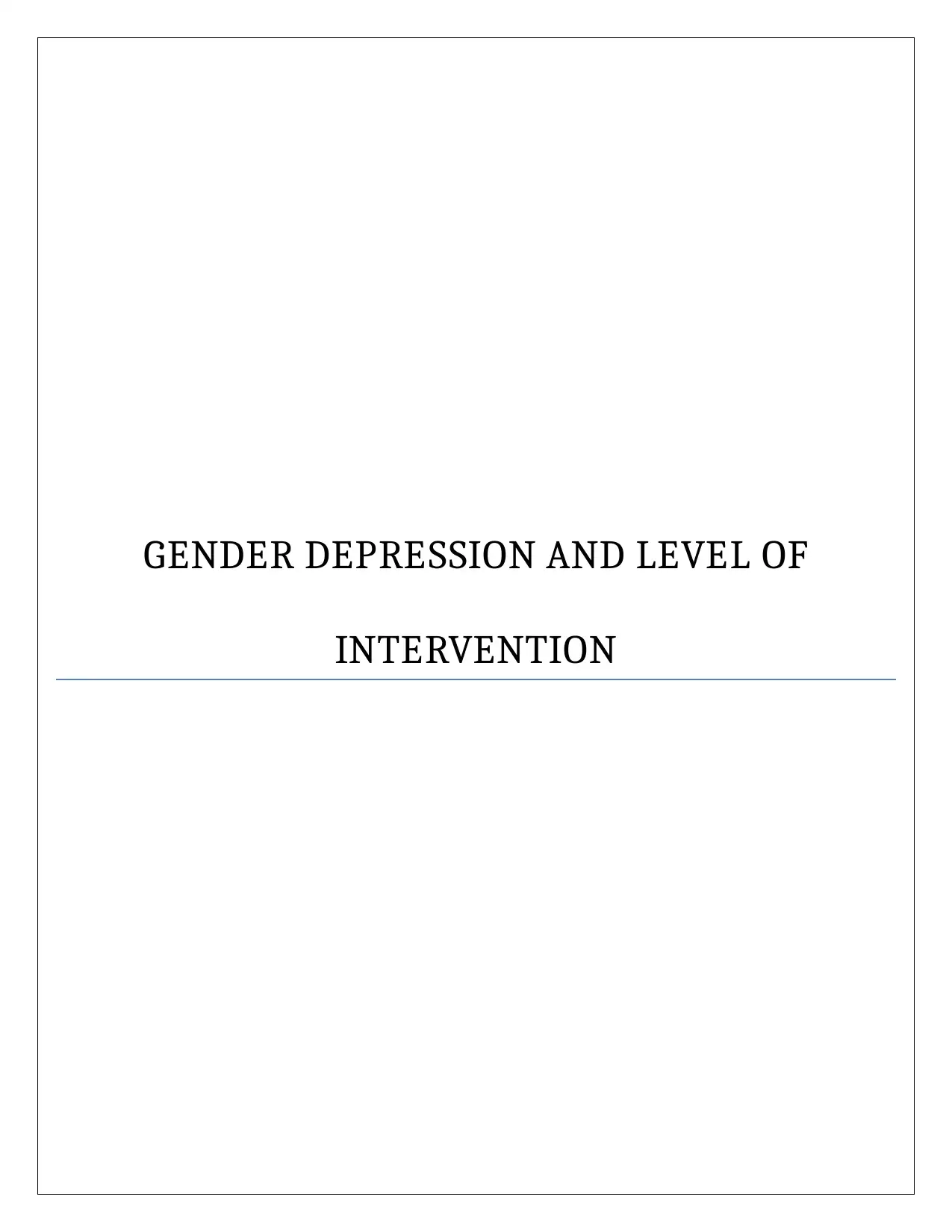
GENDER DEPRESSION AND LEVEL OF
INTERVENTION
INTERVENTION
Paraphrase This Document
Need a fresh take? Get an instant paraphrase of this document with our AI Paraphraser
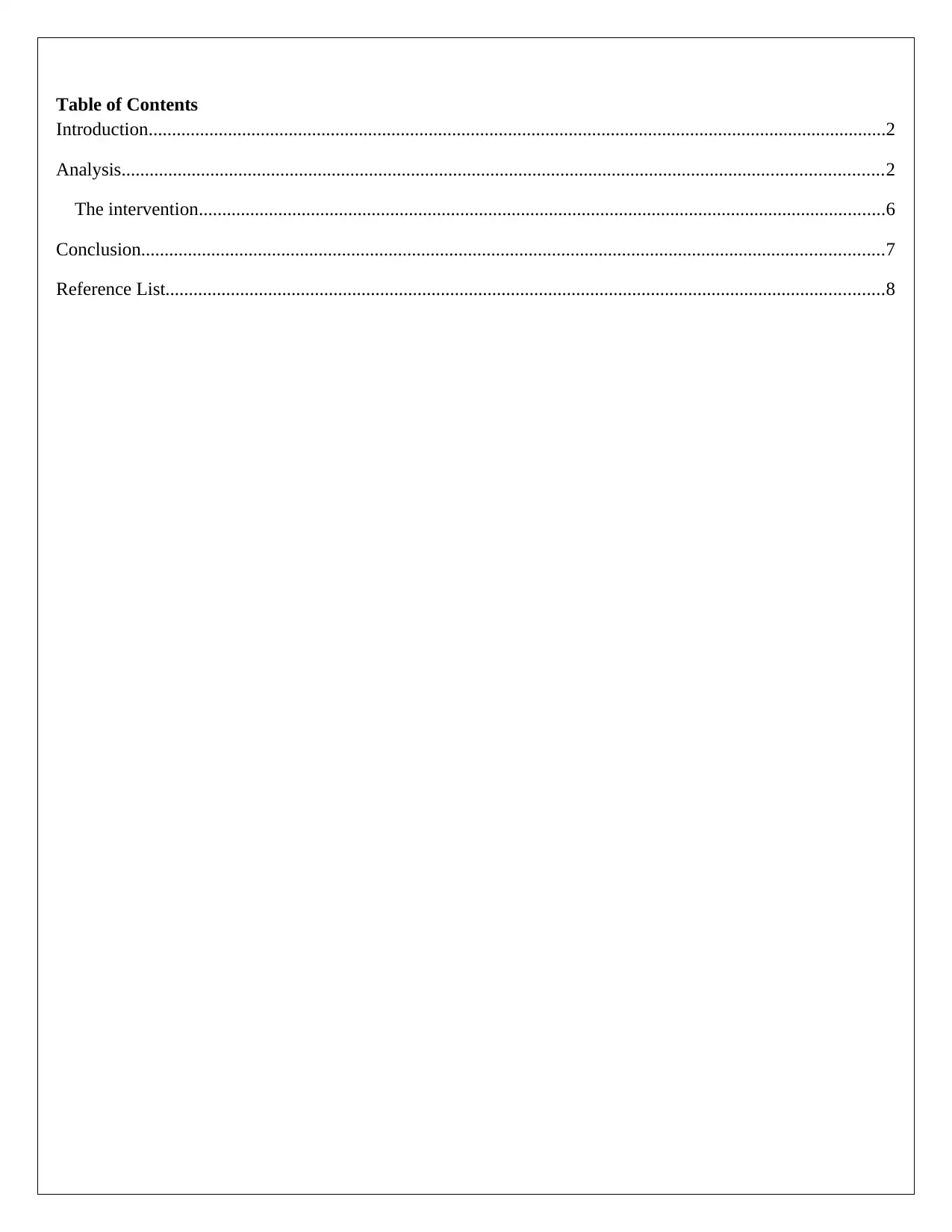
Table of Contents
Introduction..............................................................................................................................................................2
Analysis...................................................................................................................................................................2
The intervention...................................................................................................................................................6
Conclusion...............................................................................................................................................................7
Reference List..........................................................................................................................................................8
Introduction..............................................................................................................................................................2
Analysis...................................................................................................................................................................2
The intervention...................................................................................................................................................6
Conclusion...............................................................................................................................................................7
Reference List..........................................................................................................................................................8
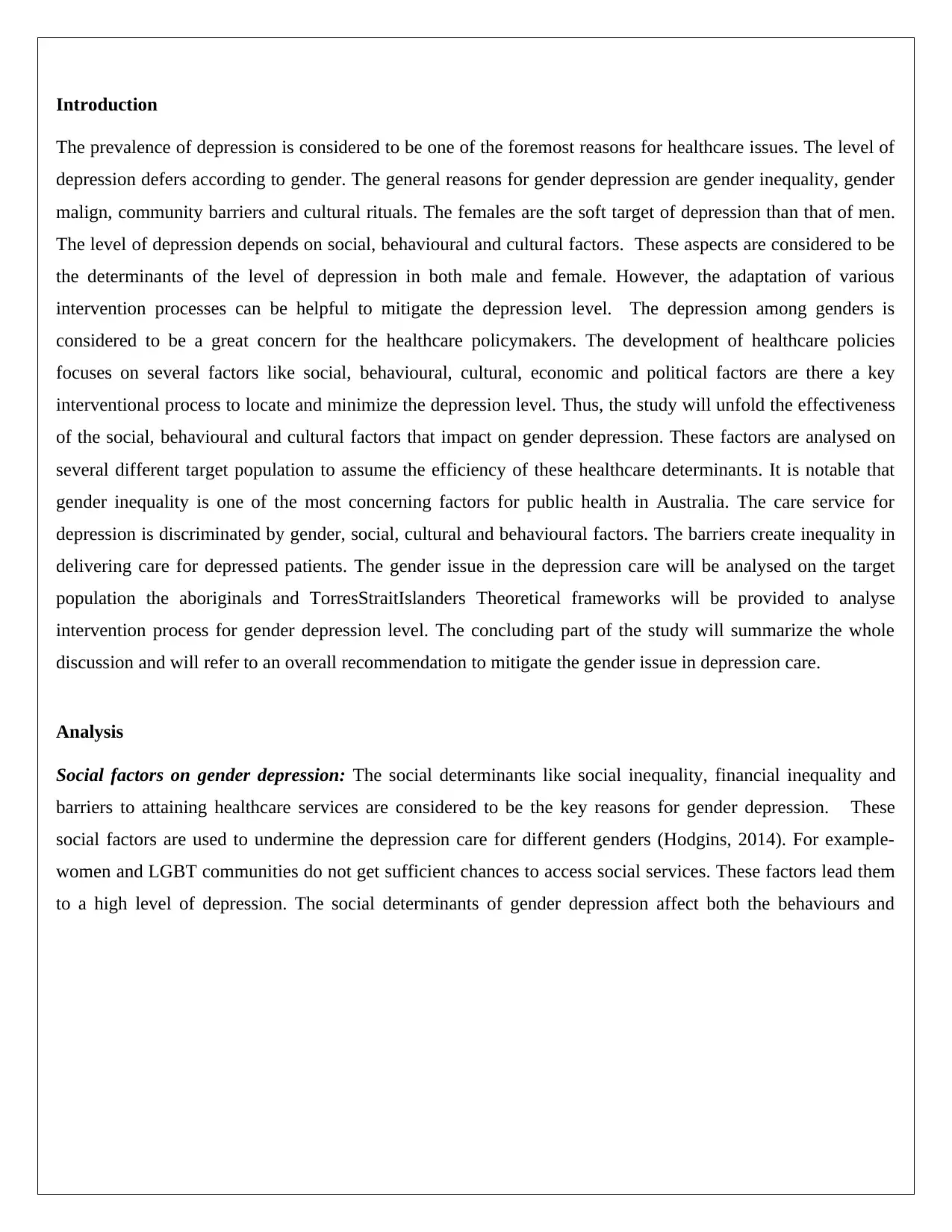
Introduction
The prevalence of depression is considered to be one of the foremost reasons for healthcare issues. The level of
depression defers according to gender. The general reasons for gender depression are gender inequality, gender
malign, community barriers and cultural rituals. The females are the soft target of depression than that of men.
The level of depression depends on social, behavioural and cultural factors. These aspects are considered to be
the determinants of the level of depression in both male and female. However, the adaptation of various
intervention processes can be helpful to mitigate the depression level. The depression among genders is
considered to be a great concern for the healthcare policymakers. The development of healthcare policies
focuses on several factors like social, behavioural, cultural, economic and political factors are there a key
interventional process to locate and minimize the depression level. Thus, the study will unfold the effectiveness
of the social, behavioural and cultural factors that impact on gender depression. These factors are analysed on
several different target population to assume the efficiency of these healthcare determinants. It is notable that
gender inequality is one of the most concerning factors for public health in Australia. The care service for
depression is discriminated by gender, social, cultural and behavioural factors. The barriers create inequality in
delivering care for depressed patients. The gender issue in the depression care will be analysed on the target
population the aboriginals and TorresStraitIslanders Theoretical frameworks will be provided to analyse
intervention process for gender depression level. The concluding part of the study will summarize the whole
discussion and will refer to an overall recommendation to mitigate the gender issue in depression care.
Analysis
Social factors on gender depression: The social determinants like social inequality, financial inequality and
barriers to attaining healthcare services are considered to be the key reasons for gender depression. These
social factors are used to undermine the depression care for different genders (Hodgins, 2014). For example-
women and LGBT communities do not get sufficient chances to access social services. These factors lead them
to a high level of depression. The social determinants of gender depression affect both the behaviours and
The prevalence of depression is considered to be one of the foremost reasons for healthcare issues. The level of
depression defers according to gender. The general reasons for gender depression are gender inequality, gender
malign, community barriers and cultural rituals. The females are the soft target of depression than that of men.
The level of depression depends on social, behavioural and cultural factors. These aspects are considered to be
the determinants of the level of depression in both male and female. However, the adaptation of various
intervention processes can be helpful to mitigate the depression level. The depression among genders is
considered to be a great concern for the healthcare policymakers. The development of healthcare policies
focuses on several factors like social, behavioural, cultural, economic and political factors are there a key
interventional process to locate and minimize the depression level. Thus, the study will unfold the effectiveness
of the social, behavioural and cultural factors that impact on gender depression. These factors are analysed on
several different target population to assume the efficiency of these healthcare determinants. It is notable that
gender inequality is one of the most concerning factors for public health in Australia. The care service for
depression is discriminated by gender, social, cultural and behavioural factors. The barriers create inequality in
delivering care for depressed patients. The gender issue in the depression care will be analysed on the target
population the aboriginals and TorresStraitIslanders Theoretical frameworks will be provided to analyse
intervention process for gender depression level. The concluding part of the study will summarize the whole
discussion and will refer to an overall recommendation to mitigate the gender issue in depression care.
Analysis
Social factors on gender depression: The social determinants like social inequality, financial inequality and
barriers to attaining healthcare services are considered to be the key reasons for gender depression. These
social factors are used to undermine the depression care for different genders (Hodgins, 2014). For example-
women and LGBT communities do not get sufficient chances to access social services. These factors lead them
to a high level of depression. The social determinants of gender depression affect both the behaviours and
⊘ This is a preview!⊘
Do you want full access?
Subscribe today to unlock all pages.

Trusted by 1+ million students worldwide
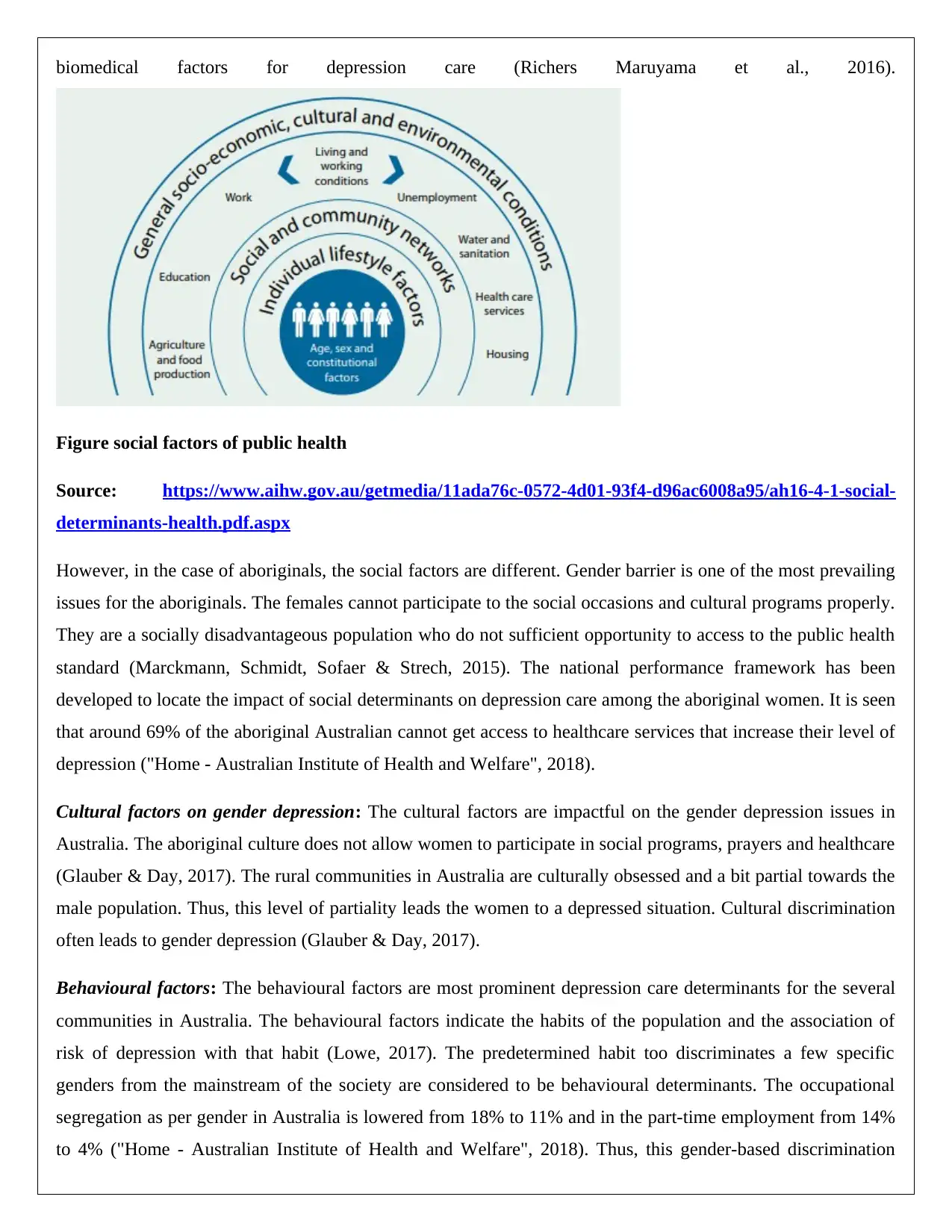
biomedical factors for depression care (Richers Maruyama et al., 2016).
Figure social factors of public health
Source: https://www.aihw.gov.au/getmedia/11ada76c-0572-4d01-93f4-d96ac6008a95/ah16-4-1-social-
determinants-health.pdf.aspx
However, in the case of aboriginals, the social factors are different. Gender barrier is one of the most prevailing
issues for the aboriginals. The females cannot participate to the social occasions and cultural programs properly.
They are a socially disadvantageous population who do not sufficient opportunity to access to the public health
standard (Marckmann, Schmidt, Sofaer & Strech, 2015). The national performance framework has been
developed to locate the impact of social determinants on depression care among the aboriginal women. It is seen
that around 69% of the aboriginal Australian cannot get access to healthcare services that increase their level of
depression ("Home - Australian Institute of Health and Welfare", 2018).
Cultural factors on gender depression: The cultural factors are impactful on the gender depression issues in
Australia. The aboriginal culture does not allow women to participate in social programs, prayers and healthcare
(Glauber & Day, 2017). The rural communities in Australia are culturally obsessed and a bit partial towards the
male population. Thus, this level of partiality leads the women to a depressed situation. Cultural discrimination
often leads to gender depression (Glauber & Day, 2017).
Behavioural factors: The behavioural factors are most prominent depression care determinants for the several
communities in Australia. The behavioural factors indicate the habits of the population and the association of
risk of depression with that habit (Lowe, 2017). The predetermined habit too discriminates a few specific
genders from the mainstream of the society are considered to be behavioural determinants. The occupational
segregation as per gender in Australia is lowered from 18% to 11% and in the part-time employment from 14%
to 4% ("Home - Australian Institute of Health and Welfare", 2018). Thus, this gender-based discrimination
Figure social factors of public health
Source: https://www.aihw.gov.au/getmedia/11ada76c-0572-4d01-93f4-d96ac6008a95/ah16-4-1-social-
determinants-health.pdf.aspx
However, in the case of aboriginals, the social factors are different. Gender barrier is one of the most prevailing
issues for the aboriginals. The females cannot participate to the social occasions and cultural programs properly.
They are a socially disadvantageous population who do not sufficient opportunity to access to the public health
standard (Marckmann, Schmidt, Sofaer & Strech, 2015). The national performance framework has been
developed to locate the impact of social determinants on depression care among the aboriginal women. It is seen
that around 69% of the aboriginal Australian cannot get access to healthcare services that increase their level of
depression ("Home - Australian Institute of Health and Welfare", 2018).
Cultural factors on gender depression: The cultural factors are impactful on the gender depression issues in
Australia. The aboriginal culture does not allow women to participate in social programs, prayers and healthcare
(Glauber & Day, 2017). The rural communities in Australia are culturally obsessed and a bit partial towards the
male population. Thus, this level of partiality leads the women to a depressed situation. Cultural discrimination
often leads to gender depression (Glauber & Day, 2017).
Behavioural factors: The behavioural factors are most prominent depression care determinants for the several
communities in Australia. The behavioural factors indicate the habits of the population and the association of
risk of depression with that habit (Lowe, 2017). The predetermined habit too discriminates a few specific
genders from the mainstream of the society are considered to be behavioural determinants. The occupational
segregation as per gender in Australia is lowered from 18% to 11% and in the part-time employment from 14%
to 4% ("Home - Australian Institute of Health and Welfare", 2018). Thus, this gender-based discrimination
Paraphrase This Document
Need a fresh take? Get an instant paraphrase of this document with our AI Paraphraser
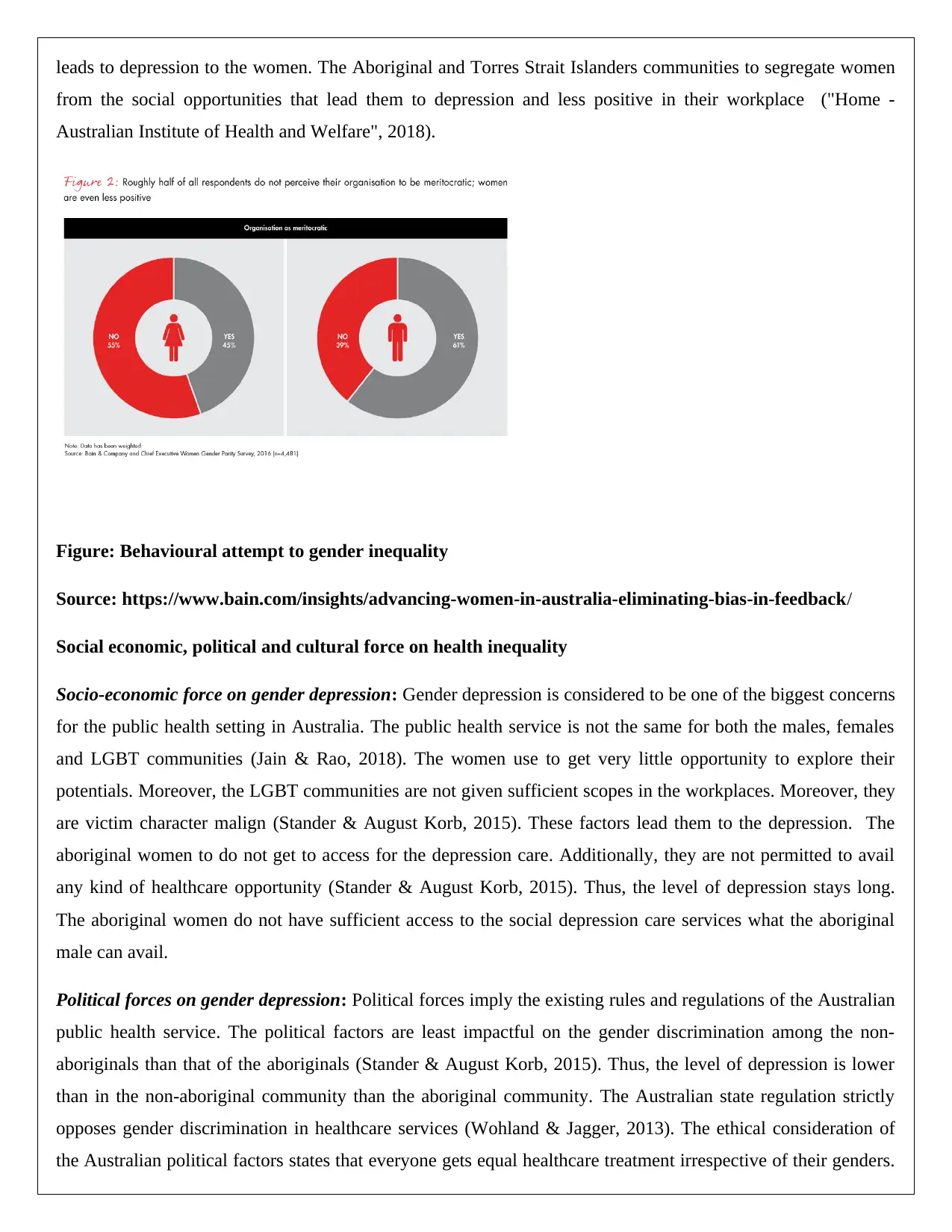
leads to depression to the women. The Aboriginal and Torres Strait Islanders communities to segregate women
from the social opportunities that lead them to depression and less positive in their workplace ("Home -
Australian Institute of Health and Welfare", 2018).
Figure: Behavioural attempt to gender inequality
Source: https://www.bain.com/insights/advancing-women-in-australia-eliminating-bias-in-feedback/
Social economic, political and cultural force on health inequality
Socio-economic force on gender depression: Gender depression is considered to be one of the biggest concerns
for the public health setting in Australia. The public health service is not the same for both the males, females
and LGBT communities (Jain & Rao, 2018). The women use to get very little opportunity to explore their
potentials. Moreover, the LGBT communities are not given sufficient scopes in the workplaces. Moreover, they
are victim character malign (Stander & August Korb, 2015). These factors lead them to the depression. The
aboriginal women to do not get to access for the depression care. Additionally, they are not permitted to avail
any kind of healthcare opportunity (Stander & August Korb, 2015). Thus, the level of depression stays long.
The aboriginal women do not have sufficient access to the social depression care services what the aboriginal
male can avail.
Political forces on gender depression: Political forces imply the existing rules and regulations of the Australian
public health service. The political factors are least impactful on the gender discrimination among the non-
aboriginals than that of the aboriginals (Stander & August Korb, 2015). Thus, the level of depression is lower
than in the non-aboriginal community than the aboriginal community. The Australian state regulation strictly
opposes gender discrimination in healthcare services (Wohland & Jagger, 2013). The ethical consideration of
the Australian political factors states that everyone gets equal healthcare treatment irrespective of their genders.
from the social opportunities that lead them to depression and less positive in their workplace ("Home -
Australian Institute of Health and Welfare", 2018).
Figure: Behavioural attempt to gender inequality
Source: https://www.bain.com/insights/advancing-women-in-australia-eliminating-bias-in-feedback/
Social economic, political and cultural force on health inequality
Socio-economic force on gender depression: Gender depression is considered to be one of the biggest concerns
for the public health setting in Australia. The public health service is not the same for both the males, females
and LGBT communities (Jain & Rao, 2018). The women use to get very little opportunity to explore their
potentials. Moreover, the LGBT communities are not given sufficient scopes in the workplaces. Moreover, they
are victim character malign (Stander & August Korb, 2015). These factors lead them to the depression. The
aboriginal women to do not get to access for the depression care. Additionally, they are not permitted to avail
any kind of healthcare opportunity (Stander & August Korb, 2015). Thus, the level of depression stays long.
The aboriginal women do not have sufficient access to the social depression care services what the aboriginal
male can avail.
Political forces on gender depression: Political forces imply the existing rules and regulations of the Australian
public health service. The political factors are least impactful on the gender discrimination among the non-
aboriginals than that of the aboriginals (Stander & August Korb, 2015). Thus, the level of depression is lower
than in the non-aboriginal community than the aboriginal community. The Australian state regulation strictly
opposes gender discrimination in healthcare services (Wohland & Jagger, 2013). The ethical consideration of
the Australian political factors states that everyone gets equal healthcare treatment irrespective of their genders.
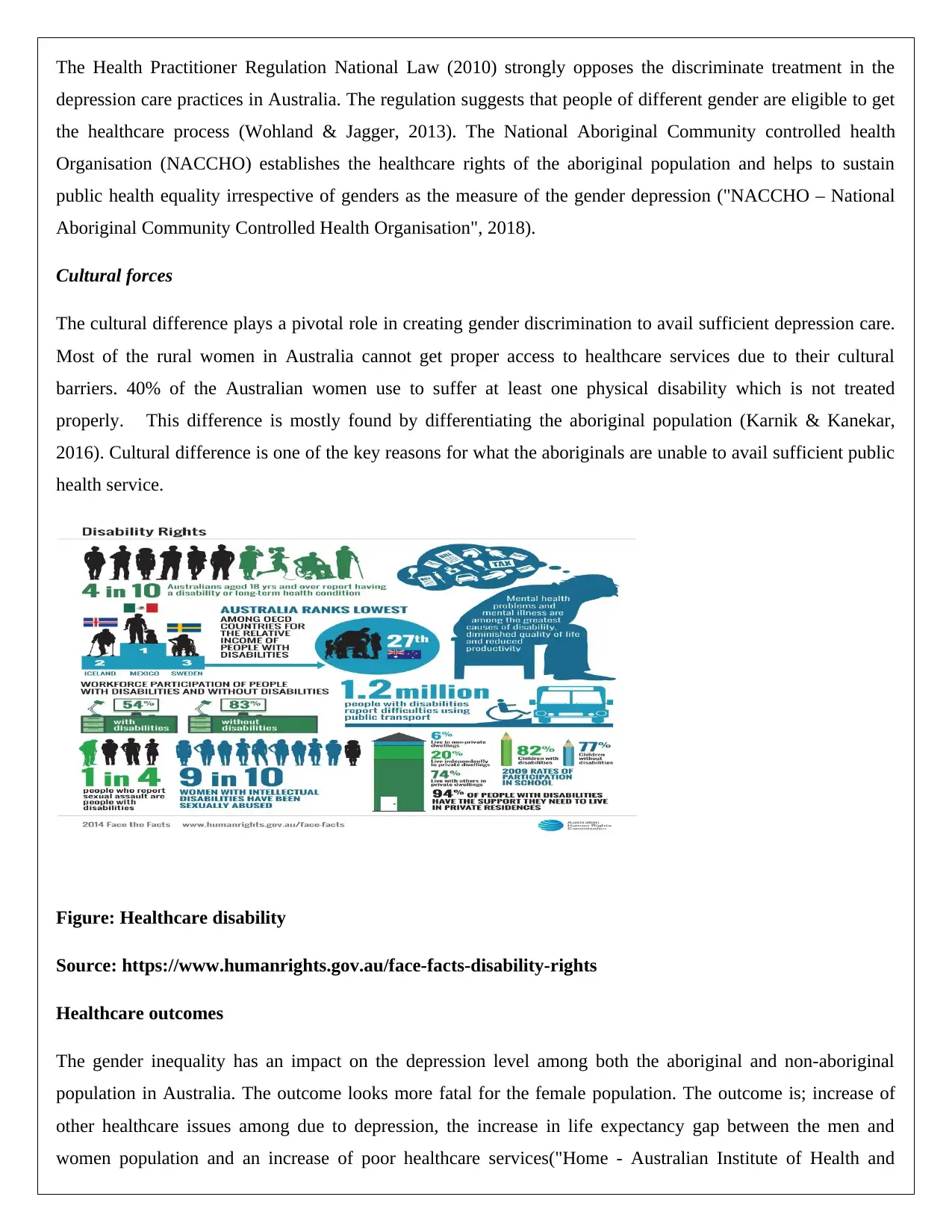
The Health Practitioner Regulation National Law (2010) strongly opposes the discriminate treatment in the
depression care practices in Australia. The regulation suggests that people of different gender are eligible to get
the healthcare process (Wohland & Jagger, 2013). The National Aboriginal Community controlled health
Organisation (NACCHO) establishes the healthcare rights of the aboriginal population and helps to sustain
public health equality irrespective of genders as the measure of the gender depression ("NACCHO – National
Aboriginal Community Controlled Health Organisation", 2018).
Cultural forces
The cultural difference plays a pivotal role in creating gender discrimination to avail sufficient depression care.
Most of the rural women in Australia cannot get proper access to healthcare services due to their cultural
barriers. 40% of the Australian women use to suffer at least one physical disability which is not treated
properly. This difference is mostly found by differentiating the aboriginal population (Karnik & Kanekar,
2016). Cultural difference is one of the key reasons for what the aboriginals are unable to avail sufficient public
health service.
Figure: Healthcare disability
Source: https://www.humanrights.gov.au/face-facts-disability-rights
Healthcare outcomes
The gender inequality has an impact on the depression level among both the aboriginal and non-aboriginal
population in Australia. The outcome looks more fatal for the female population. The outcome is; increase of
other healthcare issues among due to depression, the increase in life expectancy gap between the men and
women population and an increase of poor healthcare services("Home - Australian Institute of Health and
depression care practices in Australia. The regulation suggests that people of different gender are eligible to get
the healthcare process (Wohland & Jagger, 2013). The National Aboriginal Community controlled health
Organisation (NACCHO) establishes the healthcare rights of the aboriginal population and helps to sustain
public health equality irrespective of genders as the measure of the gender depression ("NACCHO – National
Aboriginal Community Controlled Health Organisation", 2018).
Cultural forces
The cultural difference plays a pivotal role in creating gender discrimination to avail sufficient depression care.
Most of the rural women in Australia cannot get proper access to healthcare services due to their cultural
barriers. 40% of the Australian women use to suffer at least one physical disability which is not treated
properly. This difference is mostly found by differentiating the aboriginal population (Karnik & Kanekar,
2016). Cultural difference is one of the key reasons for what the aboriginals are unable to avail sufficient public
health service.
Figure: Healthcare disability
Source: https://www.humanrights.gov.au/face-facts-disability-rights
Healthcare outcomes
The gender inequality has an impact on the depression level among both the aboriginal and non-aboriginal
population in Australia. The outcome looks more fatal for the female population. The outcome is; increase of
other healthcare issues among due to depression, the increase in life expectancy gap between the men and
women population and an increase of poor healthcare services("Home - Australian Institute of Health and
⊘ This is a preview!⊘
Do you want full access?
Subscribe today to unlock all pages.

Trusted by 1+ million students worldwide
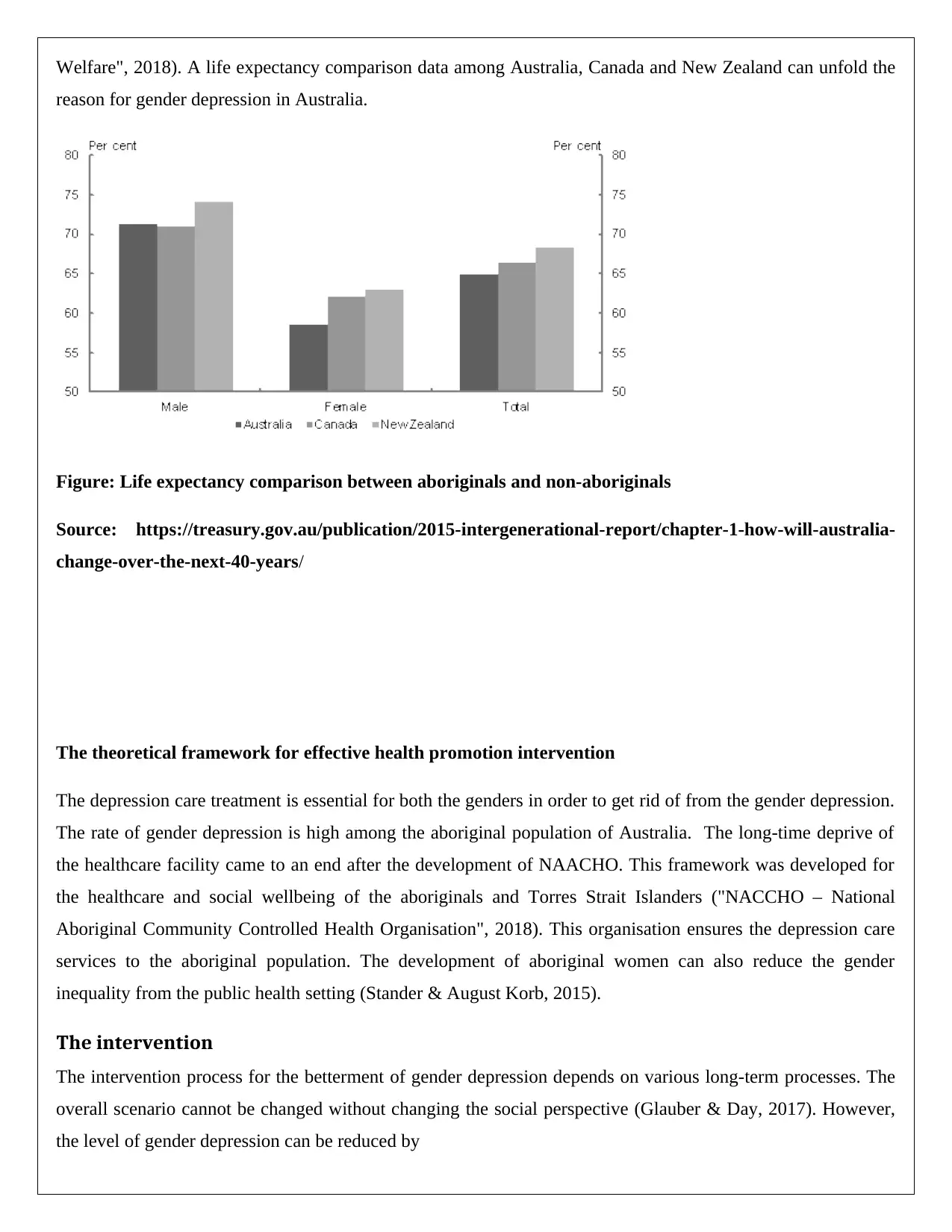
Welfare", 2018). A life expectancy comparison data among Australia, Canada and New Zealand can unfold the
reason for gender depression in Australia.
Figure: Life expectancy comparison between aboriginals and non-aboriginals
Source: https://treasury.gov.au/publication/2015-intergenerational-report/chapter-1-how-will-australia-
change-over-the-next-40-years/
The theoretical framework for effective health promotion intervention
The depression care treatment is essential for both the genders in order to get rid of from the gender depression.
The rate of gender depression is high among the aboriginal population of Australia. The long-time deprive of
the healthcare facility came to an end after the development of NAACHO. This framework was developed for
the healthcare and social wellbeing of the aboriginals and Torres Strait Islanders ("NACCHO – National
Aboriginal Community Controlled Health Organisation", 2018). This organisation ensures the depression care
services to the aboriginal population. The development of aboriginal women can also reduce the gender
inequality from the public health setting (Stander & August Korb, 2015).
The intervention
The intervention process for the betterment of gender depression depends on various long-term processes. The
overall scenario cannot be changed without changing the social perspective (Glauber & Day, 2017). However,
the level of gender depression can be reduced by
reason for gender depression in Australia.
Figure: Life expectancy comparison between aboriginals and non-aboriginals
Source: https://treasury.gov.au/publication/2015-intergenerational-report/chapter-1-how-will-australia-
change-over-the-next-40-years/
The theoretical framework for effective health promotion intervention
The depression care treatment is essential for both the genders in order to get rid of from the gender depression.
The rate of gender depression is high among the aboriginal population of Australia. The long-time deprive of
the healthcare facility came to an end after the development of NAACHO. This framework was developed for
the healthcare and social wellbeing of the aboriginals and Torres Strait Islanders ("NACCHO – National
Aboriginal Community Controlled Health Organisation", 2018). This organisation ensures the depression care
services to the aboriginal population. The development of aboriginal women can also reduce the gender
inequality from the public health setting (Stander & August Korb, 2015).
The intervention
The intervention process for the betterment of gender depression depends on various long-term processes. The
overall scenario cannot be changed without changing the social perspective (Glauber & Day, 2017). However,
the level of gender depression can be reduced by
Paraphrase This Document
Need a fresh take? Get an instant paraphrase of this document with our AI Paraphraser
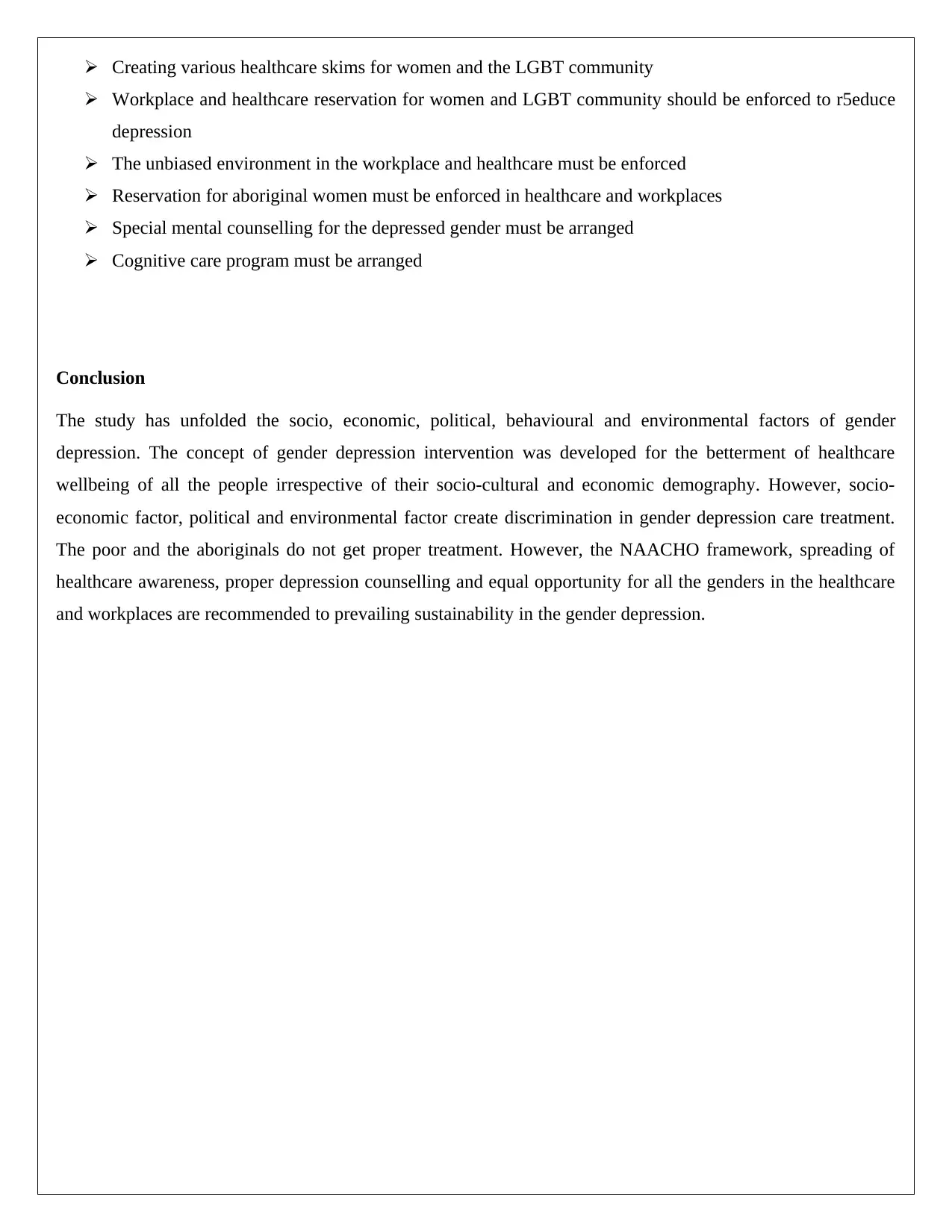
Creating various healthcare skims for women and the LGBT community
Workplace and healthcare reservation for women and LGBT community should be enforced to r5educe
depression
The unbiased environment in the workplace and healthcare must be enforced
Reservation for aboriginal women must be enforced in healthcare and workplaces
Special mental counselling for the depressed gender must be arranged
Cognitive care program must be arranged
Conclusion
The study has unfolded the socio, economic, political, behavioural and environmental factors of gender
depression. The concept of gender depression intervention was developed for the betterment of healthcare
wellbeing of all the people irrespective of their socio-cultural and economic demography. However, socio-
economic factor, political and environmental factor create discrimination in gender depression care treatment.
The poor and the aboriginals do not get proper treatment. However, the NAACHO framework, spreading of
healthcare awareness, proper depression counselling and equal opportunity for all the genders in the healthcare
and workplaces are recommended to prevailing sustainability in the gender depression.
Workplace and healthcare reservation for women and LGBT community should be enforced to r5educe
depression
The unbiased environment in the workplace and healthcare must be enforced
Reservation for aboriginal women must be enforced in healthcare and workplaces
Special mental counselling for the depressed gender must be arranged
Cognitive care program must be arranged
Conclusion
The study has unfolded the socio, economic, political, behavioural and environmental factors of gender
depression. The concept of gender depression intervention was developed for the betterment of healthcare
wellbeing of all the people irrespective of their socio-cultural and economic demography. However, socio-
economic factor, political and environmental factor create discrimination in gender depression care treatment.
The poor and the aboriginals do not get proper treatment. However, the NAACHO framework, spreading of
healthcare awareness, proper depression counselling and equal opportunity for all the genders in the healthcare
and workplaces are recommended to prevailing sustainability in the gender depression.
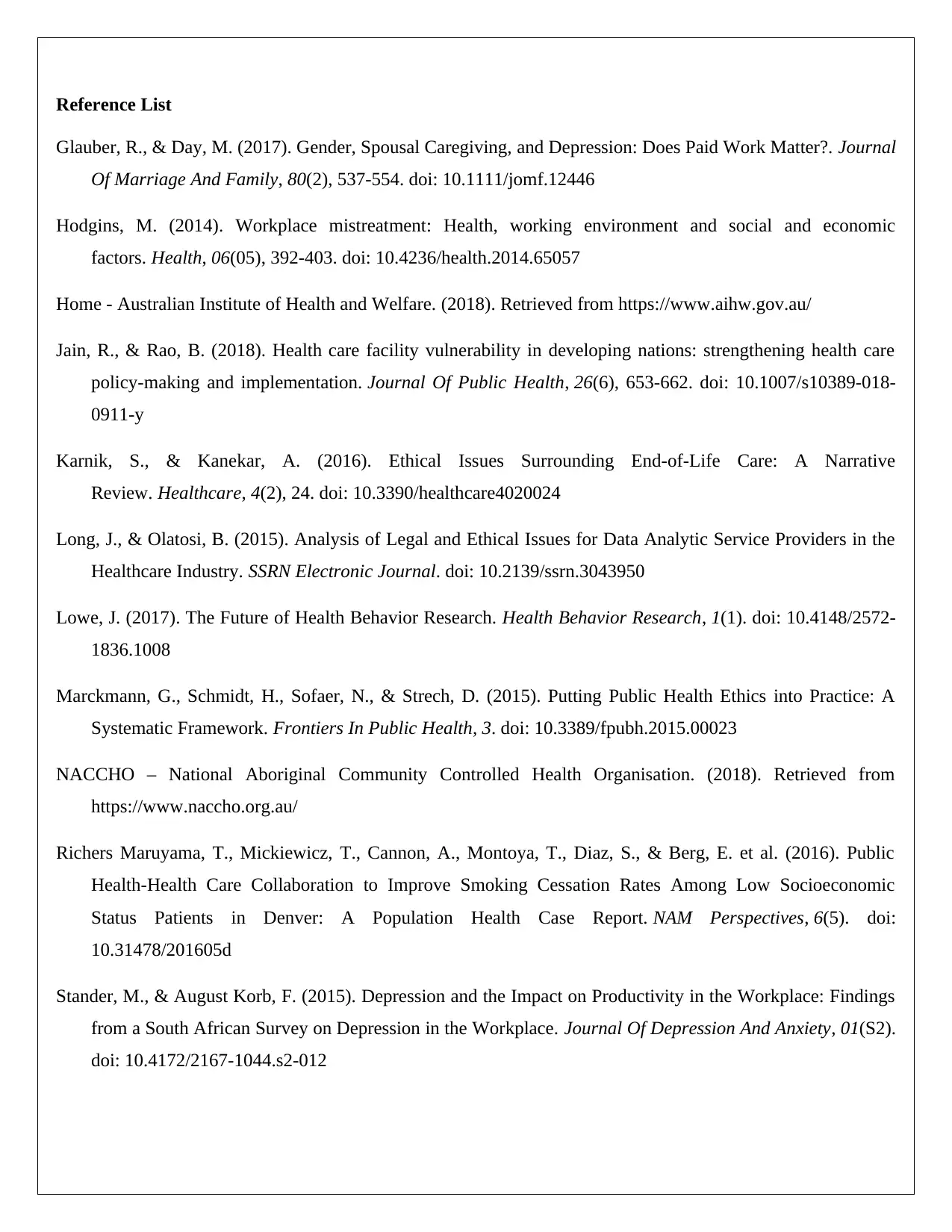
Reference List
Glauber, R., & Day, M. (2017). Gender, Spousal Caregiving, and Depression: Does Paid Work Matter?. Journal
Of Marriage And Family, 80(2), 537-554. doi: 10.1111/jomf.12446
Hodgins, M. (2014). Workplace mistreatment: Health, working environment and social and economic
factors. Health, 06(05), 392-403. doi: 10.4236/health.2014.65057
Home - Australian Institute of Health and Welfare. (2018). Retrieved from https://www.aihw.gov.au/
Jain, R., & Rao, B. (2018). Health care facility vulnerability in developing nations: strengthening health care
policy-making and implementation. Journal Of Public Health, 26(6), 653-662. doi: 10.1007/s10389-018-
0911-y
Karnik, S., & Kanekar, A. (2016). Ethical Issues Surrounding End-of-Life Care: A Narrative
Review. Healthcare, 4(2), 24. doi: 10.3390/healthcare4020024
Long, J., & Olatosi, B. (2015). Analysis of Legal and Ethical Issues for Data Analytic Service Providers in the
Healthcare Industry. SSRN Electronic Journal. doi: 10.2139/ssrn.3043950
Lowe, J. (2017). The Future of Health Behavior Research. Health Behavior Research, 1(1). doi: 10.4148/2572-
1836.1008
Marckmann, G., Schmidt, H., Sofaer, N., & Strech, D. (2015). Putting Public Health Ethics into Practice: A
Systematic Framework. Frontiers In Public Health, 3. doi: 10.3389/fpubh.2015.00023
NACCHO – National Aboriginal Community Controlled Health Organisation. (2018). Retrieved from
https://www.naccho.org.au/
Richers Maruyama, T., Mickiewicz, T., Cannon, A., Montoya, T., Diaz, S., & Berg, E. et al. (2016). Public
Health-Health Care Collaboration to Improve Smoking Cessation Rates Among Low Socioeconomic
Status Patients in Denver: A Population Health Case Report. NAM Perspectives, 6(5). doi:
10.31478/201605d
Stander, M., & August Korb, F. (2015). Depression and the Impact on Productivity in the Workplace: Findings
from a South African Survey on Depression in the Workplace. Journal Of Depression And Anxiety, 01(S2).
doi: 10.4172/2167-1044.s2-012
Glauber, R., & Day, M. (2017). Gender, Spousal Caregiving, and Depression: Does Paid Work Matter?. Journal
Of Marriage And Family, 80(2), 537-554. doi: 10.1111/jomf.12446
Hodgins, M. (2014). Workplace mistreatment: Health, working environment and social and economic
factors. Health, 06(05), 392-403. doi: 10.4236/health.2014.65057
Home - Australian Institute of Health and Welfare. (2018). Retrieved from https://www.aihw.gov.au/
Jain, R., & Rao, B. (2018). Health care facility vulnerability in developing nations: strengthening health care
policy-making and implementation. Journal Of Public Health, 26(6), 653-662. doi: 10.1007/s10389-018-
0911-y
Karnik, S., & Kanekar, A. (2016). Ethical Issues Surrounding End-of-Life Care: A Narrative
Review. Healthcare, 4(2), 24. doi: 10.3390/healthcare4020024
Long, J., & Olatosi, B. (2015). Analysis of Legal and Ethical Issues for Data Analytic Service Providers in the
Healthcare Industry. SSRN Electronic Journal. doi: 10.2139/ssrn.3043950
Lowe, J. (2017). The Future of Health Behavior Research. Health Behavior Research, 1(1). doi: 10.4148/2572-
1836.1008
Marckmann, G., Schmidt, H., Sofaer, N., & Strech, D. (2015). Putting Public Health Ethics into Practice: A
Systematic Framework. Frontiers In Public Health, 3. doi: 10.3389/fpubh.2015.00023
NACCHO – National Aboriginal Community Controlled Health Organisation. (2018). Retrieved from
https://www.naccho.org.au/
Richers Maruyama, T., Mickiewicz, T., Cannon, A., Montoya, T., Diaz, S., & Berg, E. et al. (2016). Public
Health-Health Care Collaboration to Improve Smoking Cessation Rates Among Low Socioeconomic
Status Patients in Denver: A Population Health Case Report. NAM Perspectives, 6(5). doi:
10.31478/201605d
Stander, M., & August Korb, F. (2015). Depression and the Impact on Productivity in the Workplace: Findings
from a South African Survey on Depression in the Workplace. Journal Of Depression And Anxiety, 01(S2).
doi: 10.4172/2167-1044.s2-012
⊘ This is a preview!⊘
Do you want full access?
Subscribe today to unlock all pages.

Trusted by 1+ million students worldwide
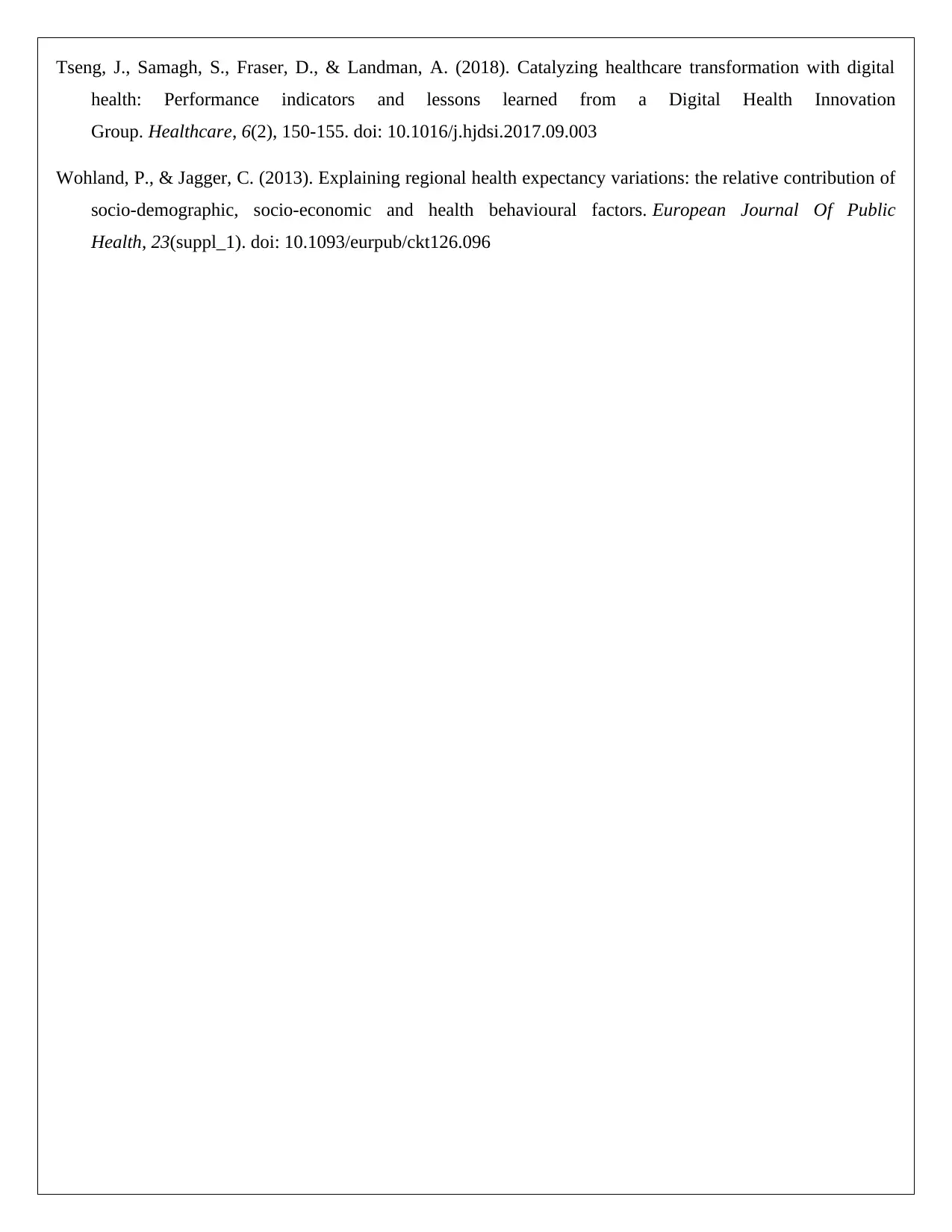
Tseng, J., Samagh, S., Fraser, D., & Landman, A. (2018). Catalyzing healthcare transformation with digital
health: Performance indicators and lessons learned from a Digital Health Innovation
Group. Healthcare, 6(2), 150-155. doi: 10.1016/j.hjdsi.2017.09.003
Wohland, P., & Jagger, C. (2013). Explaining regional health expectancy variations: the relative contribution of
socio-demographic, socio-economic and health behavioural factors. European Journal Of Public
Health, 23(suppl_1). doi: 10.1093/eurpub/ckt126.096
health: Performance indicators and lessons learned from a Digital Health Innovation
Group. Healthcare, 6(2), 150-155. doi: 10.1016/j.hjdsi.2017.09.003
Wohland, P., & Jagger, C. (2013). Explaining regional health expectancy variations: the relative contribution of
socio-demographic, socio-economic and health behavioural factors. European Journal Of Public
Health, 23(suppl_1). doi: 10.1093/eurpub/ckt126.096
1 out of 10
Related Documents
Your All-in-One AI-Powered Toolkit for Academic Success.
+13062052269
info@desklib.com
Available 24*7 on WhatsApp / Email
![[object Object]](/_next/static/media/star-bottom.7253800d.svg)
Unlock your academic potential
Copyright © 2020–2025 A2Z Services. All Rights Reserved. Developed and managed by ZUCOL.





